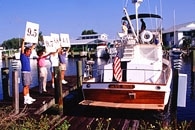
Acroboatics
We compiled the BOATING Skills Challenge to rate and illustrate a few important tricks of the trade. These are especially useful when operating bigger vessels or planning a cruise. We set up shop at the Florida Sailing and Cruising School in North Fort Myers, Florida. (Naturally, we ignored the sailing part.) At the helm of a 36′ Grand Banks, powered by 135-hp Ford Lehman diesels, we ran through our lessons with Captain Gary Graham, a veteran instructor at the Cruising School. To offer a novice’s perspective, BOATING’s managing editor, Nancy Nisselbaum, also took the challenge. We assigned each skill a degree of difficulty, rating them from 1 to 5, with 1 being the easiest. How do you become so adept at these tasks, we asked? “Simple,” says Graham. “Do them a thousand times.” But first you need somebody to show you how. Here they are – make time to practice them until they become second nature. And just remember: Docks are not the enemy.
Slip and Slide (Backing Into a Slip)
Degree of Difficulty: 3
Application: If you have dreams of owning a big boat, guess what? You’re going to have to back it into a slip almost every time you use it. The perfect slip would have three to five feet of room on either side of a centered boat when docked and be sheltered from the effects of wind and current. Good luck finding one. Even so, with a little practice, no slip should be intimidating. And if you mess up, don’t panic. Just pull away and start again.
Captain Gary’s Lesson: The first thing Graham has to say about docking is, “Don’t make the boat do everything itself.” In other words, assess the state of the current and wind and make them work for you rather than against you. And instead of frenetically pumping the throttles and gears, sometimes it’s better to do nothing. The wind will catch the boat’s freeboard and push it in the direction it’s blowing, so keep the hullsides out of the direct wind as much as possible. An ideal docking wind blows from directly behind the slip; a nightmare wind blows directly into it. The current is also a major factor; it will push the entire boat in one direction, so take its direction and force into account and compensate accordingly. If you work it right, you can use the wind and current to ease into your slip with minimal input at the helm.
Once you’ve established how to work with the elements, it’s time to set the helm. On a twin-engine boat, turn the helm hardover one way and never touch it again. If you’re aligned to back in to port, turn the rudders hardover to port. Let the engines do the rest of the work. When working the engines, avoid false commands. If the rudders are turned to port, for instance, don’t put the port engine into forward gear. That would counteract against the rudders and the boat won’t respond. To make the bow swing to starboard with the rudder so turned, engage the starboard engine in reverse. To get the bow moving to port, engage the starboard engine forward, using port reverse for correction.
Before you start backing, fix on a relative bearing – a nearby piling or moored boat perhaps – to judge if your boat is moving forward, in reverse, or not at all. Then use the engine controls to maneuver the boat. Don’t engage the engines for long. Rather, use short, alternating bursts of forward and reverse to get the boat to back gently into the slip and to straighten it out. There’s no set time that either engine should be engaged or disengaged. This comes through feel, so practice. One final tip: Don’t forget about the swim platform. “Most people, when they’re up on the flying bridge backing in, can’t see the platform,” says Graham. “They don’t account for it and…crunch!”
Nancy’s Remarks: You’re supposed to put your bow into the wind before you dock. That’s why I’m standing there like a puppy dog, turning my face to see which way my hair ruffles. Thank goodness Graham pointed out the flags on the bow and stern. Duh, they’re not there for decoration. Hey, don’t laugh. I came home from this adventure able to dock a 36′ boat.
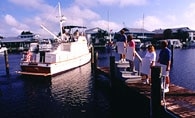
Acroboatics
Parallel Parking (Docking In the Wind)
Degree of Difficulty: 4
Application: You’ll need to dock side-to, also known as face docking, when pulling up to a crowded gas dock or restaurant. It usually involves squeezing between two other boats. “Almost to a student,” says Graham, “when we start to practice the face dock, they say it’s harder than backing into a slip.”
Captain Gary’s Lesson: The first thing Graham has to say about docking is, “Don’t make the boat do everything itself.” In other words, assess the state of the current and wind and make them work for you rather than against you. And instead of frenetically pumping the throttles and gears, sometimes it’s better to do nothing. The wind will catch the boat’s freeboard and push it in the direction it’s blowing, so keep the hullsides out of the direct wind as much as possible. An ideal docking wind blows from directly behind the slip; a nightmare wind blows directly into it. The current is also a major factor; it will push the entire boat in one direction, so take its direction and force into account and compensate accordingly. If you work it right, you can use the wind and current to ease into your slip with minimal input at the helm.
Once you’ve established how to work with the elements, it’s time to set the helm. On a twin-engine boat, turn the helm hardover one way and never touch it again. If you’re aligned to back in to port, turn the rudders hardover to port. Let the engines do the rest of the work. When working the engines, avoid false commands. If the rudders are turned to port, for instance, don’t put the port engine into forward gear. That would counteract against the rudders and the boat won’t respond. To make the bow swing to starboard with the rudder so turned, engage the starboard engine in reverse. To get the bow moving to port, engage the starboard engine forward, using port reverse for correction.
Before you start backing, fix on a relative bearing-a nearby piling or moored boat perhaps-to judge if your boat is moving forward, in reverse, or not at all. Then use the engine controls to maneuver the boat. Don’t engage the engines for long. Rather, use short, alternating bursts of forward and reverse to get the boat to back gently into the slip and to straighten it out. There’s no set time that either engine should be engaged or disengaged. This comes through feel, so practice. One final tip: Don’t forget about the swim platform. “Most people, when they’re up on the flying bridge backing in, can’t see the platform,” says Graham. “They don’t account for it and…crunch!”
Nancy’s Remarks: You’re supposed to put your bow into the wind before you dock. That’s why I’m standing there like a puppy dog, turning my face to see which way my hair ruffles. Thank goodness Graham pointed out the flags on the bow and stern. Duh, they’re not there for decoration. Hey, don’t laugh. I came home from this adventure able to dock a 36′ boat.
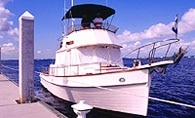
Acroboatics
Parallel Parking (Docking Side-to)
Degree of Difficulty: 4
Application: You’ll need to dock side-to, also known as face docking, when pulling up to a crowded gas dock or restaurant. It usually involves squeezing between two other boats. “Almost to a student,” says Graham, “when we start to practice the face dock, they say it’s harder than backing into a slip.”
Captain Gary’s Lesson: Whatever you’ve learned about wind and current also applies here. First order of business: Always approach into the wind or current, whichever is stronger. Always let the wind work for you. Start by leading with the bow coming into the dock – the wind will aid you in holding off and slow your forward momentum. In this situation, though, keep the rudders perfectly centered. Again, use the engines against each other (never at the same time; always have only one – or none – engine engaged) to ease the stern into the space. By working the engines, you should be able to ease the stern toward the dock without moving the boat forward or backward. If you engage your gears and the boat doesn’t respond the way you thought it would, your rudder angles are probably off.
Nancy’s Remarks: Finding the correct angle of approach to the dock was the hardest part for me. Graham would show me where to aim, and, logically, it always looked off. He was right, of course, but it took a while before I intuitively understood the approach angle.
Spin Cycle (Turning Within Your Boat’s Length)
Degree of Difficulty: 1
Application: When entering a crowded marina or anchorage, you’ll often have to spin your boat around in tight quarters to position it for docking or dropping the hook. Thankfully, this is relatively easy to master – it doesn’t take long to learn how to spin tighter than a dime.
Captain Gary’s Lesson: Turning within your boat’s own length involves the same principles as backing into a slip. Set the rudder to either port or starboard and let the engines do the work. Again, take into account wind and current, and use them to your advantage. As with docking, select a fixed bearing and use it to determine whether you’re going forward, backward, or at rest. This is especially important when turning in your own length. When you see or feel the boat start to go forward, throw the gear you’ve engaged in neutral, then shift the opposite engine into reverse. It’s another touch-feel scenario, but you should quickly get the hang of it.
Nancy’s Remarks: This sounds a lot harder than it looks – especially when you’re looking at a large boat. The key is finding and using that fixed bearing. Let it tell you where you are and in which direction you’re spinning.
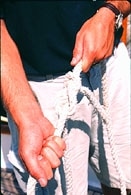
Acroboatics
Tying Game (The Proper Knots)
Degree of Difficulty: 2
Application: We concentrated on three knots: the bowline, the clove hitch, and the cleat hitch. Use the bowline to make quick loops to throw around pilings or thick cleats, the clove hitch to tie off your fenders, and the cleat hitch to quickly secure your boat. Once somebody shows you how, they’re all remarkably easy. Practice these at home over the winter with a length of spare dockline so they become second nature.
Captain Gary’s lesson: The rabbit goes through the hole and around the tree…. It’s hard to explain how to tie knots without visual aids, but Graham has a unique way of making a bowline that, once mastered, takes about 10 seconds. It involves making a loop in the line to the appropriate size, flipping your hand through the loop and feeding the tag end back through the twist you created. As for the clove hitch, that’s as simple as wrapping a loop of the fender line around a rail, crossing the line over and around, then slipping the tag end through the created hitch so that it points opposite of the standing end. The most important thing to remember when cleating off a line is to make sure that the pressure is not on the release end, or you’ll have a devil of a time unfastening it. For a more complete explanation of nautical knots, refer to The Klutz Book of Knots by John Cassidy (Klutz Inc., 1985).
Nancy’s Remarks: Okay, I admit it. Bowlines are my enemy. I think the only way to master these is to pretend you’re studying to be a surgeon. Always carry a length of line with you, and whenever your hands are idle, put them to work tying knots. I will master the bowline eventually.
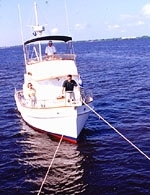
Acroboatics
Holding Steady (Setting Two Anchors)
Degree of Difficulty: 3
Application: Setting two anchors is an old cruiser’s trick for increased security when you stop for the night. Ideally, this will help you hold fast in all conditions.
Captain Gary’s Lesson: The idea here is to drop two anchors equidistant from each other to create an equilateral triangle between the anchors and the boat. When setting any anchor, let out at least seven times as much rode as the depth of your anchorage spot, making sure you count the feet from your pulpit to the waterline as part of the depth. So if you’re anchoring in 16′ of water and your pulpit’s 4′ off the waterline, let out 140′ of anchor line for each anchor. (Here’s a tip to measure scope: Grab a length of line and hold it as you spread your arms to their entire wingspan. Your wingspan is roughly the same as your height.) If you drop anchor at low tide, make sure to accommodate for high tide.
Once you set the first anchor, bring the boat forward, keeping the set rode taut until it’s parallel with the wind waves and the boat is at a right angle to the wind direction, then drop the second anchor – making sure the rode length is equal. When the second rode is taut, you should have a perfect triangle. Nancy’s Remarks: I got the length of rode all right and was able to lower and set the anchor, but figuring the angles and getting the ropes taut went just a little over my head. Perhaps with a bit more practice, but for now, I’m not ready to be first mate when it comes to anchoring.
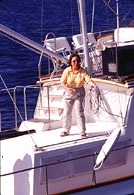
Acroboatics
Rescue 911 (Man Overboard)
Degree of Difficulty: 2 ½
Application: When someone goes overboard, the last thing you should do is jump in after him – then you’re dealing with two people in the water. The best way to handle a MOB is to assign one person to keep an eye on the victim and let the captain do a little deft boat handling.
Captain Gary’s Lesson: Splash! Someone’s in the water. What’s the first thing you do? Grab a life ring – attached to a long length of line – and toss it toward the victim. Hold the line so that it uncoils off your hand. Once the ring is in the water, it’s the captain’s job to maneuver in ever tighter circles to steer the life ring to the victim. Once the victim grabs hold, kill the engines and pull him to safety. Sound easy? Not exactly. Practice by jettisoning a large fender and then trying to get the life ring as close to it as you can.
Nancy’s Remarks: The most important lesson here is designating someone to keep an eye on the person in the water. If there’s any kind of chop, a human head is awfully difficult to find among the whitecaps.
Crabbing
Degree of Difficulty: 5
Application: You won’t encounter too many situations where you’ll have to move your boat directly sideways like a crab (hence the name), which is a good, because it’s not easy. You may have to crab in a face-docking situation where the space between boats is way too tight to fit any other way.
Captain Gary’s Lesson: A lot of boats aren’t capable of this maneuver. Crabbing is an art. It involves manipulating the throttles in short bursts (usually a no-no while docking) along to the rudders and clutches to get the boat moving sideways before the boat has a chance to make either headway or sternway. If you feel like learning an expert trick, this is one to try. Not up to it? Buy bow and stern thrusters.
Nancy’s Remarks: Where do I buy a bow thruster? Better yet, I’ll only crab with Capt. Gary aboard.
For more information about the Florida Sailing and Cruising School, contact Barbara Hansen at Southwest Florida Yachts, Dept. B, 3444 Marinatown Ln. NW, N. Fort Myers, FL 33903, 800/262-7939, www.flsailandcruiseschool.com.
Fear No Dock
Repeat after me: “Docks are not the enemy. They’re not intimidating. They’re not out to get me. There’s nothing sinister about them.” Sure, you’re thinking, easy to say that while reading a magazine, but when you’re backing into a slip narrower than Kate Moss’ hips, with the wind and tide pushing you toward a Feadship, it’s a different story. The easiest thing to do, naturally, is dive off the flying bridge and swim away, leaving the docking to some other unlucky sap. Or you can enroll in BOATING’s Skills Challenge class and master the arts you’ll need behind the helm. You’ll gain new levels of confidence and never fear the dock again.









